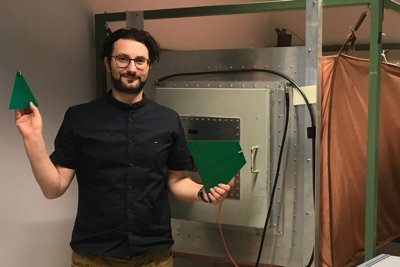Development of a Hybrid Semi-Anechoic/Reverberation Chamber for Radiated Immunity Testing of Complex Systems
Danilo Izzo is a PhD student in the Department Power Electronics. (Co)Promotors are prof.dr.ir. F.B.J. Leferink and dr. R.A. Vogt-Ardatjew from the Faculty of Electrical Engineering, Mathematics and Computer Science.
 The rapid expansion of new technologies in the automotive industry, such as those used by the advanced driver-assistance system necessitates efficient compliance with the electromagnetic environments where these devices are installed. The Electro-Magnetic Compatibility (EMC) discipline provides both the normative and technological framework that enables interoperability between electronic systems coexisting in the same electromagnetic environment, aiming to reduce potential vulnerabilities. However, as technology advances rapidly, it becomes increasingly important for the normative framework to evolve and research new methodologies to bridge the gap between existing standards and the challenges posed by these emerging technologies.
The rapid expansion of new technologies in the automotive industry, such as those used by the advanced driver-assistance system necessitates efficient compliance with the electromagnetic environments where these devices are installed. The Electro-Magnetic Compatibility (EMC) discipline provides both the normative and technological framework that enables interoperability between electronic systems coexisting in the same electromagnetic environment, aiming to reduce potential vulnerabilities. However, as technology advances rapidly, it becomes increasingly important for the normative framework to evolve and research new methodologies to bridge the gap between existing standards and the challenges posed by these emerging technologies.
This thesis investigates a testing methodology used to assess the susceptibility of electronic devices to high-strength electric fields, known as the Hybrid Chamber. A Hybrid Chamber is a specialized electromagnetic testing environment that combines features of two types of chambers: Semi-Anechoic Chamber and Vibrating Intrinsic Reverberation Chamber (VIRC). This hybrid design leverages the advantages of both environments, making it suitable for a wide range of EMC testing scenarios. The methodology involves using the VIRC as a more robust testing strategy to identify potential susceptibility issues in the device under test. Subsequently, the operator can "raise the VIRC" to transition to the SAC, where a more accurate analysis is performed, with the antenna positioned in front of the device exhibiting issues.
The thesis begins with theoretical and experimental investigations into the electromagnetic field properties observed for the Hybrid Chamber used as VIRC during these tests. It then delves into methods for controlling field intensity, uniformity, and the dynamic behavior of the electromagnetic field during the stirring process. These aspects are examined through a series of comparisons between numerical simulations, empirical data, and practical examples, drawing from the author’s research at both the Hybrid Chamber and a smaller VIRC at the University of Twente, where the author conducted his research.




